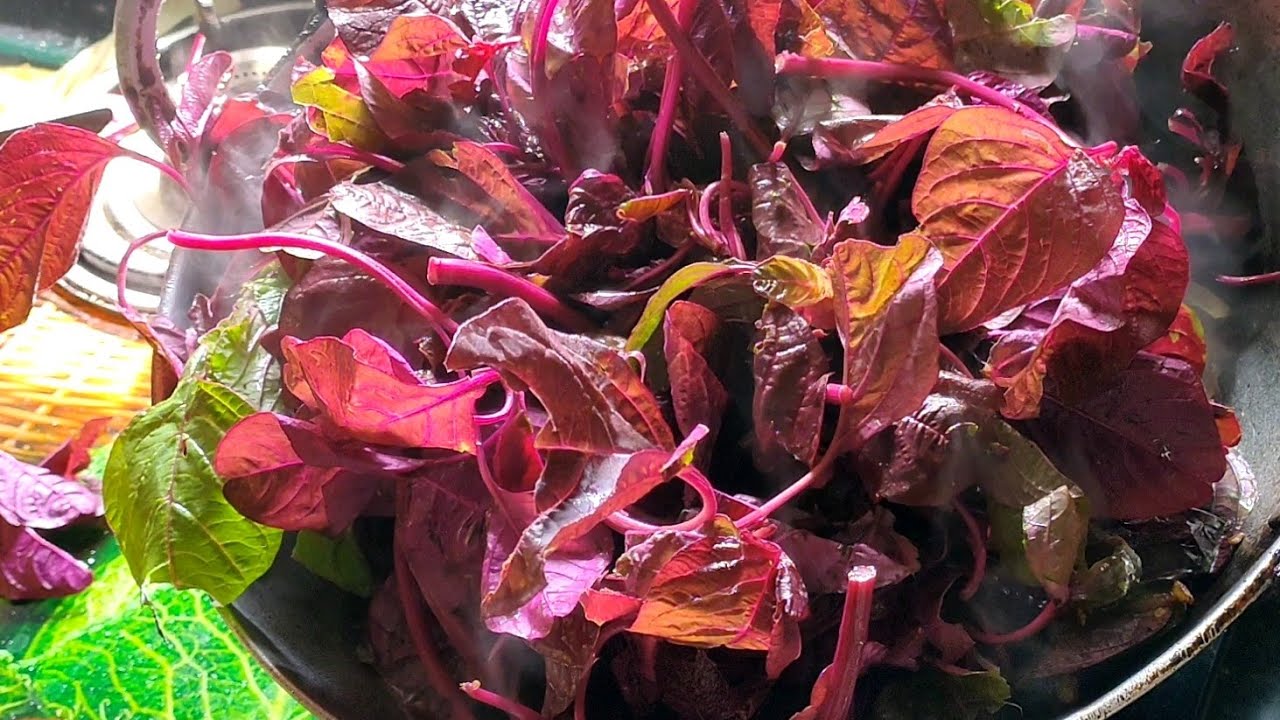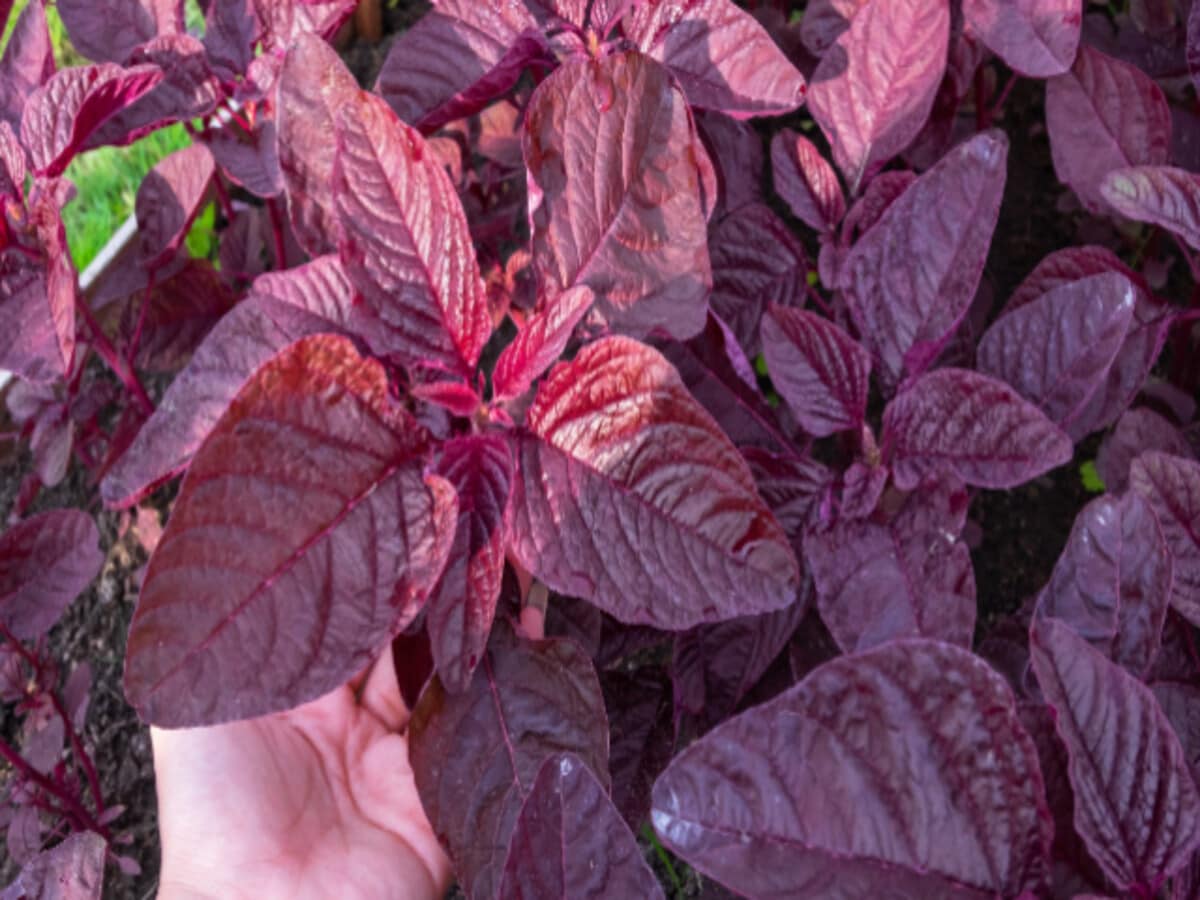प्याज की खेती एक महत्वपूर्ण कृषि प्रक� ...
Red spinach, known as "लाल साग" in Hindi, is a nutrient-rich leafy vegetable that stands out due to its red leaves, making it unique from other greens. Not only is red spinach beneficial for health, but it can also be a profitable business for farmers. In this article, we’ll explore the complete process and benefits of red spinach farming.
लाल साग, जिसे अंग्रेजी में "Red Spinach" कहते हैं, एक पोषक तत्वों से भरपूर हरी पत्तेदार सब्जी है। यह सामान्य साग से कुछ अलग है, क्योंकि इसकी पत्तियाँ लाल रंग की होती हैं, जो इसे अन्य सागों से अलग पहचान देती हैं। लाल साग की खेती न केवल आपकी सेहत के लिए फायदेमंद है, बल्कि यह किसानों के लिए एक लाभकारी व्यवसाय भी साबित हो सकता है। इस लेख में हम लाल साग की खेती के बारे में विस्तार से जानेंगे...
पोषक तत्वों से भरपूर: लाल साग में विटामिन A, C, आयरन, और फॉलिक एसिड जैसे महत्वपूर्ण पोषक तत्व होते हैं, जो शरीर को मजबूती प्रदान करते हैं। यह रक्त की कमी (एनीमिया) को दूर करने में मदद करता है और पाचन तंत्र को भी मजबूत करता है।
जलवायु और मिट्टी की अनुकूलता: लाल साग गर्म और नम जलवायु में बेहतर उगता है, जो भारत के अधिकांश हिस्सों में उपलब्ध है। यह हल्की दोमट मिट्टी में अच्छी तरह से उगता है, लेकिन इसके लिए मिट्टी का उचित जल निकासी होना जरूरी है।
जलवायु की सहनशीलता: लाल साग ठंडी और गर्म दोनों मौसम में उगाया जा सकता है, लेकिन यह ठंडे मौसम में ज्यादा अच्छा फलता-फूलता है। यह ठंडे मौसम में भी अपनी बढ़त बनाए रखता है, और गर्मी में इसके पत्ते बहुत मोटे हो जाते हैं।

बीज चयन: लाल साग के अच्छे उत्पादन के लिए गुणवत्तापूर्ण बीज का चयन करना महत्वपूर्ण है। बाज़ार में लाल साग के विभिन्न किस्में उपलब्ध हैं, जिनमें से आप उपयुक्त किस्म का चयन कर सकते हैं।
भूमि की तैयारी: लाल साग की खेती के लिए मिट्टी को अच्छे से पलटकर उसे समतल किया जाता है। खेत में मिट्टी की उर्वरता बढ़ाने के लिए खाद डालना जरूरी होता है। गोबर की खाद या जैविक खाद का उपयोग किया जा सकता है।
लाल साग की बुवाई मानसून के बाद या सर्दियों के मौसम में की जा सकती है। बीजों को खेत में 2-3 सेंटीमीटर की गहराई पर बोया जाता है। बीजों के बीच पर्याप्त दूरी रखनी चाहिए ताकि पौधों को बढ़ने के लिए पर्याप्त स्थान मिल सके।
लाल साग को नियमित रूप से पानी की आवश्यकता होती है, लेकिन अत्यधिक पानी से बचना चाहिए क्योंकि इससे जड़ सड़ सकती है। शुरुआती अवस्था में अधिक पानी की आवश्यकता होती है, लेकिन जैसे-जैसे पौधे बड़े होते हैं, पानी की मात्रा कम कर दी जाती है।

लाल साग को पर्याप्त पोषण के लिए गोबर की खाद या अन्य जैविक उर्वरक दिए जा सकते हैं। जैविक उर्वरकों का उपयोग मिट्टी की गुणवत्ता को बेहतर बनाता है और उत्पादन में वृद्धि करता है।
लाल साग की खेती में समय-समय पर खरपतवारों को निकालना चाहिए और कीटनाशकों का उपयोग कम से कम करना चाहिए। जैविक तरीके से कीट नियंत्रण करने की कोशिश करें ताकि सब्जियों में रासायनिक अवशेष न रहें।
यह भी पढ़ें: मसूर की खेती | बथुआ की खेती
लाल साग की कटाई तब की जाती है जब पौधे लगभग 4-5 महीने पुराने हो जाएं और उनकी पत्तियाँ पूरी तरह से विकसित हो जाएं। इसे हाथ से काटा जाता है और ताजे रूप में बाज़ार में बेचा जाता है। लाल साग की मांग आमतौर पर अधिक होती है, खासकर शहरी इलाकों में जहां लोग स्वास्थ्य के प्रति जागरूक हो रहे हैं।
लाल साग की खेती किसानों के लिए एक बेहतर विकल्प हो सकती है, खासकर उन क्षेत्रों में जहां अन्य फसलों का उत्पादन कम होता है। यह उच्च मूल्य वाली सब्जी है, और इसकी मांग निरंतर बढ़ रही है।
इसके अलावा, लाल साग के पौधे की खेती से पर्यावरण पर भी सकारात्मक प्रभाव पड़ता है क्योंकि यह कार्बन डाइऑक्साइड को अवशोषित करता है और ऑक्सीजन का उत्सर्जन करता है।
लाल साग की खेती किसानों के लिए एक लाभकारी और स्वास्थ्यवर्धक विकल्प हो सकती है। यह न केवल कृषि में विविधता लाता है, बल्कि यह बाजार में उच्च कीमत पर बिकने वाली सब्जी के रूप में भी उभर कर सामने आता है। अगर आप खेती में कुछ नया और लाभकारी करना चाहते हैं, तो लाल साग की खेती एक बेहतरीन विकल्प साबित हो सकती है।
यह भी देखे -
Youtube video 📷- लाल साग की खेती
Nutrient-Rich: Red spinach is packed with essential nutrients like Vitamin A, Vitamin C, iron, and folic acid. It helps combat anemia, strengthens the digestive system, and boosts overall health.
Suitable Climate and Soil: Red spinach grows best in warm and humid climates, making it ideal for most regions of India. It thrives in light loamy soil with good drainage.
Climate Resilience: Red spinach can be grown in both cold and warm seasons. However, it performs better in cooler weather. In cold conditions, it maintains steady growth, while in hot climates, its leaves become thicker.
Seed Selection: For a good yield, selecting high-quality seeds is crucial. Various varieties of red spinach seeds are available in the market, and you can choose the one best suited to your region.
Land Preparation: The soil is tilled and leveled properly for red spinach farming. Adding manure, such as cow dung or organic fertilizers, increases soil fertility.
Red spinach can be sown after the monsoon or during winter. Seeds are sown at a depth of 2–3 cm in the soil. Maintain adequate spacing between seeds to allow plants enough room to grow.
Red spinach requires regular watering, but overwatering should be avoided to prevent root rot. Initially, frequent watering is essential, but as the plants grow, the frequency can be reduced.
Use organic fertilizers or manure to ensure adequate nutrition for the plants. Organic fertilizers improve soil quality and boost production.
Weeds should be removed periodically, and the use of chemical pesticides should be minimized. Opt for organic pest control methods to ensure the vegetables remain chemical-free.
Red spinach is harvested when the plants are about 4–5 months old and the leaves are fully developed. It is harvested manually and sold fresh in the market. The demand for red spinach is generally high, especially in urban areas where people are more health-conscious.
Red spinach farming can be an excellent option for farmers, particularly in areas where other crops yield less. It is a high-value vegetable with increasing demand.
Additionally, red spinach farming has environmental benefits as it absorbs carbon dioxide and releases oxygen into the atmosphere.
Red spinach farming is a profitable and health-beneficial choice for farmers. It not only adds diversity to agriculture but also stands out as a high-value crop in the market. If you're looking to try something new and beneficial in farming, red spinach cultivation could be a great option.
0
0
प्याज की खेती एक महत्वपूर्ण कृषि प्रक� ...
Potatoes are a versatile and widely consumed root vegetable, rich in nutrients such as carbohydrates ...
Garlic is a widely used spice and medicinal plant cultivated for centuries. It is known for its spic ...
Coriander farming offers lucrative returns for farmers due to its high demand in the culinary and me ...
September is an ideal month for sowing various vegetables that can be harvested in the cooler months ...
Ghiya, also known as bottle gourd, is a popular and nutritious vegetable grown in many parts of Indi ...
Tomato farming is a popular agricultural practice due to the high demand for tomatoes worldwide. It ...
खीरा की खेती एक लाभदायक कृषि व्यवसाय ह ...
अक्टूबर का महीना शरद ऋतु का प्रारंभ हो ...
Beetroot cultivation is a profitable agricultural venture that involves growing a nutritious root ve ...
Tauri, also known as Ridge Gourd, is a popular vegetable cultivated in many parts of Asia. It is hig ...
Eggplant, also known as Brinjal or Solanum melongena, is a widely cultivated vegetable in India, pri ...
Pea (Pisum sativum) is one of the major legume crops in India, used both as a vegetable and a pulse. ...
Chickpea (Cicer arietinum) is an important pulse crop, particularly grown in India. Its cultivation ...
Sem, also known as ‘Beans,’ is a significant leguminous crop that is not only rich in nutrition ...
Bathua (Chenopodium album) is a nutritious leafy vegetable commonly grown during the winter season i ...
Lentils (Lens culinaris) are a valuable pulse crop grown in India during the Rabi season. Known for ...
The winter season is an excellent time for farmers, especially for cultivating vegetables. Vegetable ...
After harvesting rice, it is important for farmers to plan for the next crop. This is the time when ...
December marks the beginning of winter, making it an ideal time for vegetable farming. This season p ...
There’s something special about enjoying freshly grown vegetables from your own home. It’s not o ...
February is an important time for agriculture, especially for farmers who are preparing for rabi and ...
Fruit drop or lack of fruiting in bottle gourd plants is a common issue, whether they are grown in s ...